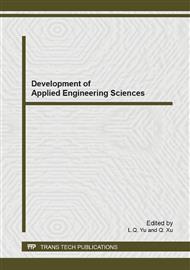[1]
Hao Zhang . Research status and development of CAD/CAM[J]. The Sixth Session of The National Computer Application Academic Conference. 2002(In Chinese).
Google Scholar
[2]
Guofu Yin , Suixian Yang . Principle and application of computer aided design and manufacturing technology[M]. Sichuan University press. 2001. 11(In Chinese).
Google Scholar
[3]
Weihua Zhang. Study on innovation technique of train bogie at high speed[J]. Engineering Sciences. 2009, 11(10): 8-18(In Chinese).
Google Scholar
[4]
Ministry of Science and Technology of the People's Republic of China. Chinese major projects of independent innovation through the acceptance of high speed train[EB/OL]. Qingdao science and Technology Bureau. 2014. 6(In Chinese).
Google Scholar
[5]
Youjie Song, Hongliang Zhang , Shusen Liu . Development and application of CAD/CAM technology in vehicle acceleration in industry[J]. 1992. 3(1-4)(In Chinese).
Google Scholar
[6]
Wang Yuhui. ANSYS and China railway locomotive industry[J] . CAD/CAM and manufacturing information. 1999. 10(In Chinese).
Google Scholar
[7]
Jihua Cheng, Yuqing Fan, Guoping Yuan, Shurong Pang . CAD/CAM Development Platform and Its Future Trend[J]. 2000. 12(2)(In Chinese).
Google Scholar
[8]
CNR startup construction project on development platform of vehicle virtual products[N] Railway E Journal. 2006. 8(In Chinese).
Google Scholar
[9]
The Secret of EMU Technology Introduction[N]. Chinese Youth Daily. 2007(In Chinese).
Google Scholar
[10]
Zerui Xiang, Bochu Xu, Jinyi Zhi. Review and Prospect of Research of Industrial Design of High-speed Train in China[J]. Journal of The China Railway Society. 2013. 35(12)(In Chinese).
Google Scholar
[11]
Guowei Xia. Analysis and Study on the interior design of high speed EMU based on Ergonomics[D]. Nanchang University. 2009. 6(In Chinese).
Google Scholar
[12]
Jinling Zhao. Study on high speed train interior design based on Universal Design[D]. Shenyang Aerospace University. 2010. 1(In Chinese).
Google Scholar
[13]
Liang Li, Bingqiang Zhang, Xiaoli Yang. Analysis of dynamic response of large cross-section tunnel under vibrating load induced by high speed train[J]. Chinese Journal of Rock Mechanics and Engineering. 2005. 24(23)(In Chinese).
Google Scholar
[14]
Wenjing Wang, Zhiming Liu, Qiang Li , Longxiu Miao. Fatigue Strength Analysis of CRH2 Motor Bogie Frame[J]. Journal of Bei Jing Jiao Tong University. 2009. 33(1): 5-9(In Chinese).
Google Scholar
[15]
Huiping Li. Research and Application on CAD/CAE Key Technology of High-Speed Train Body[D]. Dalian Jiao Tong University, 2012. 6(In Chinese).
Google Scholar
[16]
Guangzhong Hu, Shoune Xiao, Shide Xiao, Zhongbin Liu. Fuzzy Reconfigurable Design Principles and Methods of Complex Mechanical Products[J]. Journal of Southwest Jiao Tong University. 2013. 48(1): 116-121(In Chinese).
Google Scholar
[17]
Guofu Yin, Jing Gan, Xiaobing Hu, Lei Xu, Erjing Cheng, Ke Chen, Yongchao Wang. Review on Modern Design Theory and Methodology oriented Information Age for Mechanical Products[J]. Journal of Si Chuan University (Engineering Science Edit 2006. 38(5) (In Chinese).
Google Scholar
[18]
P Dabke,V. Prabhaker,S. Sheppard. using feature to support finite element idealisation[C]. Proc. ASME Computer in Engineering Conf, Minneapolis, 1994: 183-193.
Google Scholar
[19]
Tworzydlo W, Oden J.T. Towards an automated environment in computational mechanics[J]. Computer Methods in Applied Mechanics and Engineering. 1993, 104: 87-143.
DOI: 10.1016/0045-7825(93)90208-f
Google Scholar
[20]
Paterson, Jim. Using CAD imaging in training and development of engineer [J]. Structural Engineer, 2003, 3: 23-25.
Google Scholar
[21]
Weiguo Gao, Yanshen Xu , Yongliang Chen, Qing Zhang. Theory and methodology of generalized modular design. Chinese Journal of Mechanical Engineering . 2007. 43(6)(In Chinese).
Google Scholar
[22]
Ming-di Zong, Ying Cai, Xudong Liu, Xiangyuan Li. A Multi-Perspective Hierarchical Division Approach for a Product in Its Modular Design[J]. Transactions of Beijing Institute of Technology 2003. 23(5): 552-556(In Chinese).
Google Scholar
[23]
Ai-ying Kang. Research on Application of CAD/ CAM Software in Mechanical Manufacturing Industry[J]. Machine China. 2013(12): 103-104(In Chinese).
Google Scholar
[24]
Weihua Zhang. Study on Top-level Design Specifications of High-speed Trains[J]. Journal of The China Railway Society. 2012. 34(9): 15-19(In Chinese).
Google Scholar
[25]
CSR Qi shuyan Locomotive Co. Ltd. Yearbook[R]. 2011(in Chinese).
Google Scholar


